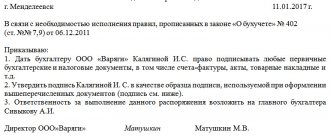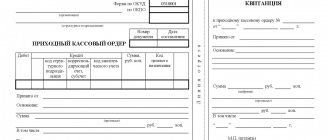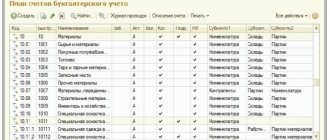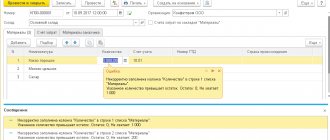Kontur.Accounting is a web service for small businesses!
Quick establishment of primary accounts, automatic tax calculation, online reporting, electronic document management, free updates and technical support.
Try it
To organize efficient production, it is important to maintain competent warehouse records. Knowing the documents used to register goods in the warehouse will help you protect your rights and keep records correctly. Correctly executed documentary support will protect against problems with the received goods and facilitate communication with the tax authorities.
Documents for registration of goods receipt
The posting of goods includes the reception and initial accounting of receipts. The goods can be accepted by a financially responsible person or a person by proxy. The receipt of goods is accompanied by the execution of primary documents by the supplier. These include:
- packing list;
- waybill (Bill of Lading) - it is needed to take into account the movements of goods and materials and pay for road transport;
- invoice.
An invoice is issued if the supplier pays VAT. An invoice allows you to offset VAT on the goods received for reimbursement. Organizations and entrepreneurs operating under the simplified taxation system do not pay value added tax and may not issue an invoice, and if the document is issued by the supplier on OSNO, they may not accept input VAT for reimbursement.
Before accepting the goods, check the correctness of the invoice: it must contain the details of the buyer and supplier, name of the product, quantity, price, cost, VAT.
The cloud service Kontur.Accounting allows you to store all information about goods in one place and simplifies the procedure for posting goods. Get free access for 14 days
To post the goods after acceptance, the invoice is stamped and signed by the responsible persons. The invoice is drawn up in two copies: one remains with the buyer, and the other is given to the seller. For the buyer, the invoice is a receipt document, and for the seller it is an expense document.
Universal transfer document (UDD)
This document is both a waybill and an invoice. Legislatively introduced in 2013 and not mandatory for use. You can decide for yourself whether you want to draw up two documents or just the UPD. Like an invoice, UTD provides the basis for obtaining a tax deduction.
The use of a universal document simplifies the process of transfer and acceptance of inventory items. Use it to formalize the supply of goods, works or services and the transfer of property rights. The UPD is signed by the authorized person responsible for the preparation of primary documents or purchase and sale transactions.
In the legally established form of the UPD there is a status field. It determines which document you are submitting the UPD instead of:
- Invoice and delivery note;
- Packing list;
- Invoice (for electronic form).
The status of the document changes the order in which it is filled out: for status 2, you do not need to fill out some lines, the UPD number and the required signatures change. To use the UPD in an organization, its form must be approved. The official form is advisory in nature, and the organization may make changes to it. But all mandatory details of the primary documents must comply with the requirements.
Small businesses and primary accounting documents
The question may be trivial, but it gives rise to different interpretations - this is the decommissioning and commissioning of goods and materials (for office use): stationery, bought a cartridge, extension cords, wires to the computer, covered the wire on the floor with a cable duct, bought furniture for the office, ordered and hung a sign on the office door with the name of the company. We have a small (even micro) enterprise, where there is a director, a chief accountant and a couple of managers. Is it enough to draw up a free-form act of commissioning? Is it also important to print out and sign the demand invoice form M-11, which stipulates that at all enterprises there is someone to release, receive, and other details through.
Of course, a plant, for example, and an enterprise of 3–10 people cannot be compared in terms of inventory movement. Please advise how best to reflect documented consumption without creating a mountain of paperwork for using a pen for 10 rubles.
In accordance with Art. 4 of the Federal Law of July 24, 2007 No. 209-FZ “On the development of small and medium-sized businesses in the Russian Federation” to small and medium-sized businesses
include consumer cooperatives and commercial organizations included in the Unified State Register of Legal Entities (
with the exception of
state and municipal unitary enterprises), as well as individuals included in the Unified State Register of Legal Entities and carrying out entrepreneurial activities without forming a legal entity, peasant (farm) farms.
The criteria for recognizing a legal entity as a small business entity are:
, in particular:
– compliance of revenue with established values
.
From July 25, 2015, revenue limits
from the sale of goods (work, services) for the previous calendar year excluding VAT for small and medium-sized businesses
are
:
microenterprises
– 120 million rubles;
small businesses
– 800 million rubles;
medium enterprises
– 2 billion rubles;
– average number of employees
for the previous calendar year
should not exceed
the following maximum values of the average number of employees for each category of small and medium-sized businesses:
from 101 to 250
people inclusive for
medium-sized enterprises
;
up to 100 people
inclusive
for small
businesses;
Among small enterprises, microenterprises
- up
to 15 people
.
The category of a small or medium-sized business entity is determined in accordance with the most significant condition.
Art. 9 of the Federal Law of December 6, 2011 No. 402-FZ “On Accounting”
It has been established that
every fact
of economic life
is subject to registration with a primary accounting document
.
The required details of the primary accounting document are
:
1)
Title of the document;
2)
date of document preparation;
3)
name of the economic entity that compiled the document;
4)
content of the fact of economic life;
5)
the value of the natural and (or) monetary measurement of a fact of economic life, indicating the units of measurement;
6)
the name of the position of the person (persons) who completed the transaction, operation and the person(s) responsible for its execution, or the name of the position of the person(s) responsible for the execution of the accomplished event;
7)
signatures of the persons
provided for in paragraph 6, indicating their last names and initials or other details necessary to identify these persons.
The primary accounting document must be drawn up when a fact of economic life is committed, and if this is not possible, immediately after its completion.
The person responsible for registration of the fact of economic life ensures the timely transfer of primary accounting documents for registration of the data contained in them in the accounting registers, as well as the reliability of this data.
The person entrusted with maintaining accounting records and the person with whom an agreement has been concluded for the provision of accounting services are not responsible for the compliance of primary accounting documents compiled by other persons with accomplished facts of economic life.
The forms of primary accounting documents are determined by the head of the economic entity
on the recommendation of the official responsible for accounting.
The primary accounting document is drawn up on paper and (or) in the form of an electronic document signed with an electronic signature.
Thus, with regard to primary accounting documents, the Accounting Law does not contain any reservations for small enterprises
.
Law No. 402-FZ establishes only the right of small businesses to use simplified methods of accounting
, including simplified accounting (financial) statements.
According to clause 22 of the Standard Recommendations for organizing accounting for small businesses
, approved by order of the Ministry of Finance of the Russian Federation dated December 21, 1998 No. 64n,
small enterprises
that carry out a small number of business transactions (usually
no more than thirty per month
) that do not carry out production of products and work associated with large costs of material resources,
can keep records all transactions by registering them only in the Book
(
journal
)
of accounting facts of economic activity
in form No. K-1.
However, in this case, in chronological sequence in a positional manner based on each primary document
All business transactions of the month are reflected.
Let us repeat that, based on Part 4 of Art. 9 of Law No. 402-FZ, primary accounting documents are compiled according to forms approved by the head of the economic entity.
In Information No. PZ-10/2012, the Ministry of Finance of the Russian Federation reported that from January 1, 2013
forms of primary accounting documents contained in albums
of unified forms
of primary accounting documentation
are not mandatory for use
.
Therefore, the organization either
continues to use unified forms,
or
develops a “primary” form independently.
As a rule, a unified form is taken and everything unnecessary is removed from it.
P. 5, 16 PBU 5/01 “Accounting for inventories”
, approved by order of the Ministry of Finance of the Russian Federation dated 06/09/2001 No. 44n, it is established that inventories
are accepted for accounting and released into production
.
In accordance with the Guidelines for accounting of inventories
for the management needs of the organization
are accepted for accounting as inventories .
All movement operations
(receipt, movement, consumption) of inventories
must be documented in primary accounting documents
(clause 11).
Materials in the organization must be posted
(paragraph 48).
Acceptance and posting
incoming materials are processed by the relevant warehouses, as a rule, by drawing up
receipt orders
(standard interindustry form No. M-4 approved by Decree of the State Statistics Committee of the Russian Federation dated October 30, 1997 No. 71a), in the absence of discrepancies between the supplier’s data and the actual data (in terms of quantity and quality) (paragraph 49).
Taking into account the requirements of Art. 9 of Law No. 402-FZ based on the form
No. M-4, you can make your own document:
All unnecessary columns have been removed, the necessary ones have been left.
.
In accordance with clause 90 of the Methodology for the release of materials for production
This means their issuance from a warehouse (storeroom) directly for the manufacture of products (performance of work, provision of services), as well as
the release of materials for the management needs of the organization
.
The cost of materials released for management needs is charged to the appropriate accounts for accounting for these expenses.
In the primary accounting documents for the issue of materials
from warehouses (storerooms) of the organization to divisions of the organization, to sites, to teams, to workplaces, the name of the material, quantity, price (registration price), amount, as well as purpose: number (code) and (or) name of the order (product, products), for the manufacture of which materials are supplied, or a number (code) and (or) name of the costs.
Primary accounting documents
for the release of materials from the organization's warehouses to the organization's divisions there are a limit card (standard interindustry form
No. M-8
), a demand invoice (standard interindustry form
No. M-11
), and an invoice (standard interindustry form No. M-15).
You can take form No. M-11 as a basis.
.
Remove unnecessary columns
(form codes, unit of measure code, transaction type code (if you did not develop them), type of activity of the sender and recipient).
On the date of issue of pens from the warehouse, for example, you will write off the cost of pens to cost accounts
.
Clause 98 of the Methodology establishes that the organization can carry out vacation
materials or their individual groups, types, names to their divisions
without indicating their purpose
.
In this case, the issue of materials is taken into account as an internal movement
, and
the materials themselves are considered subordinate
to the unit that received them.
For actually consumed materials, the department receiving the materials draws up a consumption report
, which indicates the name, quantity, accounting price and amount for each item, number (code) and (or) name of the order (product, product) for the manufacture of which they were used, or number (code) and (or) name of the costs, quantity and amount according to consumption standards, quantity and amount of consumption in excess of standards and their reasons; where necessary, the quantity of manufactured products or the volume of work performed is indicated.
However, if in the primary accounting document you indicate
(and you can additionally indicate a lot) that
the pens were transferred, for example, to the AUP for management purposes, then the need to draw up an expense report does not arise
.
After all, the purpose of the materials sold is indicated in the “primary” document.
Pens can be received by a secretary or accountant, or another person designated as responsible for receiving office inventory items.
Then there is no need for registration of employees in the primary office.
The recipient will be the responsible person.
Office furniture, in principle, meets the criteria for recognition of an asset as an item of fixed assets
, established by clause 4
of PBU 6/01 “Accounting for fixed assets”
, approved by order of the Ministry of Finance of the Russian Federation dated March 30, 2001 No. 26n.
For accounting purposes, purchased furniture
, satisfying the conditions for accepting an asset for accounting as part of fixed assets,
should have been reflected in account 01
“Fixed assets”
with subsequent depreciation
.
At the same time, assets in respect of which the conditions provided for in paragraph 4 of PBU 6/01 are met, and the cost
within the limit established in the accounting policy of the organization, but
not more than 40,000 rubles per unit, may be reflected
in accounting and financial statements
as part of inventories
.
In order to ensure the safety of these objects in production or during operation, the organization must organize proper control over their movement
(clause 5 of PBU 6/01).
Therefore, you have the right to reflect office furniture
worth less than RUB 40,000. as part of the MPZ on account 10
“Materials”.
In accordance with paragraph 93 of the Methodology,
as materials are released from the warehouses
(storerooms) of the unit to sites, teams,
and workplaces, they are written off
from the material asset accounts and
credited to the corresponding production cost accounts
.
The cost of materials released for management needs is charged to the appropriate accounts for accounting for these expenses.
That is, when putting furniture into operation, you will write off its cost as expenses.
to the corresponding accounts (20, 26, 44).
To monitor the safety
inexpensive furniture, reflect its cost
on a free off-balance sheet account
.
Since, unlike, for example, a computer, a separate piece of furniture may well perform its functions independently
, and not as part of a set, then you
have the right to account for furniture items as separate inventory objects
and write off the cost of “inexpensive” objects as expenses at a time.
In a letter dated May 30, 2006 No. 03-03-04/4/98, the Ministry of Finance of the Russian Federation explained that if an organization decides to take such items into account as part of inventories, it must maintain appropriate accounting cards for them
(receipt order in form No. M-4, demand invoice in form No. M-11, materials accounting card in form No. M-17, etc.).
That is, the same primary accounting documents that we reviewed above.
Acceptance of goods
The cloud service Kontur.Accounting allows you to store all information about goods in one place and simplifies the procedure for posting goods. Get free access for 14 days
At the first stage of acceptance of goods, we check whether the type and quantity of goods corresponds to the information in the accompanying documents. This is necessary to ensure completeness of accounting. The second stage is acceptance of the goods for quality and completeness. Acceptance of goods is carried out by the materially responsible person in the presence of a representative of the supplier, unless other conditions are specified in the contract. If all goods are in place and no defects are found, confirm compliance with the organization’s stamp and signature.
Based on the results of acceptance of the goods, a TORG-1 act and a TORG-11 product label are drawn up. Product label data is needed to conduct an inventory list.
Violation of the inspection deadlines and acceptance rules will deprive you of the right to file a claim against the supplier or carrier. For certain types of goods, the terms are established by law, for others they are specified in the contract. Registration of the return of low-quality goods depends on the moment of detection of the defect:
- if a shortage of goods or defects is detected during acceptance, the commission draws up a report on the discrepancy in quantity and quality; the act is drawn up in the TORG-2 form; if properly executed, it will serve as the basis for making claims;
- when a defect is discovered after the goods are registered, an invoice is drawn up indicating the quantity of the goods being returned, a statement of identified defects, a letter of claim and a return invoice;
- if one of the types of goods was not delivered to you, cross them out from the invoice and adjust the invoice.
At the end of acceptance, capitalize the received goods and materials according to the actual quantity and amount.
What to do if there are no accompanying documents
The cloud service Kontur.Accounting allows you to store all information about goods in one place and simplifies the procedure for posting goods. Get free access for 14 days
For accounting, the main thing is documents. If there is no document, there is no accounting object. When a supply agreement is available, but the supplier has not provided accompanying documents, the goods received must also be capitalized.
For such cases, a TORG-4 acceptance certificate is provided. In the absence of a delivery note and an invoice, it is difficult to determine the price at which the goods arrive. The price must be taken from the contract, and if there is no contract, then the goods are purchased at the market price. The TORG-4 act contains information about the actual availability of the received goods.
The acceptance certificate is drawn up by a special commission that accepts the goods. TORG-4 is drawn up in two copies, one is transferred to the financially responsible person of the supplier, and the other to the accounting department.
Capitalization of materials based on inventory results
After receipt, goods are moved, put into operation, written off, etc., and at some point it is necessary to carry out an audit to calculate how many materials are actually in the warehouse and, if necessary, capitalize excess goods or write off missing ones.
The posting of materials in 1C 8.3 can be done through the “Posting of Goods - Warehouse”.
Fig.6 Receipt of materials
It is not necessary to create an inventory document; in a new document, indicating the article “Capitalization of surplus”, you can select and fill in the goods manually, as well as their quantity, price and indicate the bill of materials.
Fig.7 Receipt of materials based on inventory results
However, it is better to do this. When creating a document, the tabular part can be filled out automatically by clicking “Fill in by stock balances”. All goods with leftovers will go there.
Fig.8 Creating an inventory document
In the “Actual quantity” column we indicate the actual availability of materials in the warehouse. If shortages are detected, then the deviation will be with a minus sign; if a surplus is found, then the “Deviation” column will contain positive amounts. In this case, the accounting account should be 10.
Fig.9 Quantity fact
The document did not generate any movements, since movements in registers and accounts will be made by capitalization and write-off documents. However, from the created “Inventory” you can print various accompanying printable forms:
Fig.10 Related printing forms
When created on the basis of the “Inventory of Materials Receipt”, only the lines for which surpluses have been determined will automatically be included in the list, data on the quantity of materials, price and account will be transferred.
Fig. 11 Inventory of materials receipt
If working with the receipt of goods in 1C causes you difficulties, contact our 1C product support specialists. We will be happy to help you!









